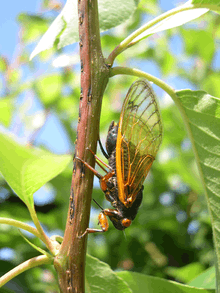Cassini periodical cicadas
The name Cassini periodical cicadas is used to group two closely related species of periodical cicadas: Magicicada cassinii (Fisher, 1852) having a 17-year lifecycle, and Magicicada tredecassini[lower-alpha 1](Alexander and Moore, 1962), a species essentially identical except for its 13-year lifecycle.

Courting behavior of Cassini cicadas is unusual because large groups of males may sing and fly together in synchrony: that is, bursts of sound, as thousands of males sing in unison, alternate with silence, as clouds of flying cicadas leave perches in unison, seeking a new perch before the next ensemble song.
Description
All Magicicada species have a black dorsal thorax with red eyes and orange wing veins.[8] Cassini periodical cicadas are smaller than decim periodical cicadas. The abdomen is black except for occasional faint orange-yellow marks on the ventral surface seen in some location.
In a typical brood of periodical cicadas, decim and decula types will be present as well as cassini. The three different types have unique species song-types; they also tend to sing at different times of day, with cassini choruses most likely in mid- to late afternoon, later than decim or decula varieties.[9] The cassini-type song consists of a series of ticks followed by a buzz; it has also been described as sounding like "someone trying to get a lawnmower started."[9]
Magicicada males seek out sunlit vegetation, where they typically gather with conspecific males to form large choruses, alternating singing behavior with short flights. Cassini-type males are unusual in synchronizing these behaviors, so that thousands of males sing their mating song in unison and then fly together.[10] according to Alexander and Moore (1958):[11]
Almost every singing male in a woods containing tens of thousands of singers achieves synchrony with all the others, and the result gives the impression of a gigantic game of musical chairs. A treeful of these insects singing in synchrony is motionless when observed during the great burst of sound caused by insects buzzing together, and then becomes a frenzy of activity between buzzes with nearly every individual changing perches.
The "congregational" singing of males (so-called because it inspires both males and females to congregate) requires this synchrony in cassini-types for its success.[11]
Habitat
Periodical cicadas live in eastern United States east of the Great Plains. Cassini-type cicadas are especially common in the most southwestern populations and are the only 17-year cicada species found in Oklahoma and Texas.[10]
Cassini-type cicadas are most often found in deciduous lowland woods and flood plains, rather than the upland woods favored by other Magicicada. [10]
Ecological impact
Egg-laying by a large brood may cause many twigs to die off but does little long-term harm to mature trees.[12]
Notes
- While the original and correct spelling for Fisher's 17-year species is cassinii,[1] with two 'i's, a large majority of publications have spelled the name cassini since the mid-1960s. However, the original spelling has been maintained throughout by taxonomic catalogues,[2][3][4][5] and the rules of nomenclature support the priority of cassinii (Article 33.4).[6] The correct spelling for the 13-year relative is tredecassini.[7]
References
- Fisher, J. C. 1852. On a new species of Cicada. Proceedings of the Academy of Natural Sciences of Philadelphia 5: 272-275.
- Sanborn, A. F. 2013. Catalogue of the Cicadoidea (Hemiptera: Auchenorrhyncha). With contributions to the bibliography by Martin H. Villet. Elsevier. Inc., Academic Press, San Diego, CA.
- Duffels, J.P., and P. A. van der Laan. 1984. Catalogue of the Cicadoidea (Homoptera, Auchenorhyncha) 1956-1980. Series Entomologica vol. 34. 414 pp. Junk, Dordrecht, Netherlands
- Metcalf, Z.P., 1963. General Catalogue of the Homoptera. Fasc. 8. Cicadoidea. Part 1: Cicadidae. vii, 919 pages. Part 2: vi, 492 pages. [Species index by Virginia Wade, 1964, 26 pp.] University of North Carolina State College, Raleigh, U.S.A.
- Dmitriev, D. 2003. 3I Interactive Keys and Taxonomic Databases.
- ICZN, 1999. International Code of Zoological Nomenclature, 4th Edition Archived 2009-05-24 at the Wayback Machine. International Trust for Zoological Nomenclature, Natural History Museum, London.
- Alexander, R.D., and T. E. Moore. 1962. The evolutionary relationships of 17-year and 13-year cicadas, and three new species (Homoptera, Cicadidae, Magicicada). Miscellaneous Publications of the Museum of Zoology of the University of Michigan 121: 1-59.
- "Periodical Cicada Page". University of Connecticut. Retrieved 14 May 2018.
- Carter, Janet L. Stein. "Periodical Cicadas". University of Cincinnati. Archived from the original on 2011-07-28. Retrieved 19 June 2011.
- Capinera, John L. (2008). Encyclopedia of Entomology. Springer. p. 2792. ISBN 1-4020-6242-7.
- Alexander, Richard D.; Thomas E. Moore (1958). "Studies on the acoustical behavior of seventeen-year cicada" (PDF). Ohio Journal of Science. 32 (2): 107–127. Retrieved 20 June 2011.
- Cook, William M.; Robert D. Holt (2002). "Periodical Cicada (Magicicada cassini) Oviposition Damage: Visually Impressive yet Dynamically Irrelevant" (PDF). American Midland Naturalist. 147: 214–224. doi:10.1674/0003-0031(2002)147[0214:PCMCOD]2.0.CO;2. Archived from the original (PDF) on 7 August 2011. Retrieved 18 June 2011.
External links
- Video of Brood XIX M. tredecassini responding to the saxophone playing of David Rothenberg, 2011
- Synchronized chorusing of M. tredecassini, 2011